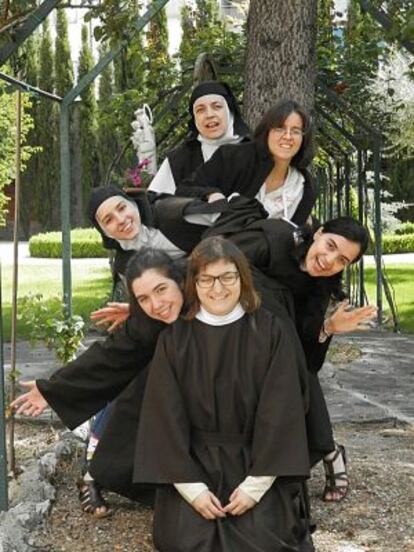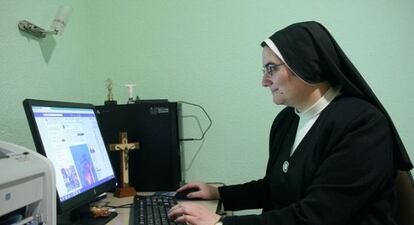The digital superhighway to Heaven
Spanish convents are finding the social networks a powerful tool to attract nuns-to-be


The appointment is inside a Catholic chapel in a Valladolid church. The guests, wearing their Sunday best, sit on benches and pull out their cellphones to take endless pictures of the star of this event, a young woman named Vanessa.
It looks like the setting for a wedding – in fact, even the dialogue sounds straight out of a marriage ceremony: “Did you come here of your own free will?” “Yes, I did.”
But a wedding it is not. “So then, she’s going to stay in here forever?” a scared-looking little boy asks his mother.
The subject of all this attention is not a bride. Vanessa has just become a cloistered nun and is about to join the congregation of the Discalced Carmelites. She will never leave the convent again. She is 29 years old.
In 1966, there were 6,695 novices in Spain, according to the conservative daily Abc. By 1980 there were fewer than 750 candidates to join a religious order; these days that figure is under 250.
Vanessa is about to join the congregation of the Discalced Carmelites. She will never leave the convent again
At a time when many Spanish convents, faced with closure due to their members’ advanced age, have had to “import” younger nuns from other countries, there is one salient exception.
The Discalced Carmelites of Valladolid are constantly welcoming new members to their congregation. In two-and-a-half years, they have increased their “staff” from 18 to 30 and brought down their average age to below 35.
This “miracle” is the work of the prioress, Olga María, who traveled to Rome in 2012 with two requests: for young women to be allowed to try being a cloistered nun for a few days, as a kind of trial run; and for the congregation to be permitted to advertise itself on the internet.
Of the 10 or so twenty-somethings who gave it a try, six of them decided to stay, explains Beatriz, one of the veterans.
These days, the Valladolid Carmelites have their own website, 8,101 likes on Facebook, 461 followers on Twitter, 1,867 subscribers to their YouTube channel, a WhatsApp account to answer queries from girls, and a presence on Livestream to provide live coverage of events like the ceremony in which Vanessa was clothed with the religious habit.
The Valladolid Carmelites have their own website, 8,101 likes on Facebook and 461 followers on Twitter
This community is now home to, among others: two 18-year-olds; a 24-year-old former boxer who was about to join the army before suddenly opting for the convent; an engineer who gave up a good salary to shut herself up inside a monastery at age 30; and a guitarist who left heavy metal behind and now only sings religious songs.
Beatriz laughs when she remembers some of their first days: one girl confessed that she had stuffed herself with pizza before the admission ceremony, thinking she would never get to try it again: “So she arrives at the convent, and what do you think is on the menu that day? Pizza!”

Other religious communities are now using social networks to gain followers as well. One of them is the congregation of the Servants of Jesus, who leave their Madrid convent at nights to care for the sick.
“If youths look for answers out there, then we have to be out there too. We have a website, we’re on Facebook and on Twitter,” explains Sister Blanca Alonso, a trainer of novices who dropped a career in architecture 23 years ago to become a nun.
Just like 63 other religious congregations, the Servants of Jesus paid a €150 fee to be listed on www.buscoalgomas.com, a website on which a young woman, wearing jeans and a t-shirt, uses colloquial language to get the following message across: “It’s possible, even if you don’t know it, that you could have a religious calling. Wait, don’t run away! Why don’t you join me and get to know this world a little better...?”
One girl stuffed herself with pizza before the admission ceremony, thinking she would never get to try it again
It was this website that turned up when Esmeralda, 22, typed “What do you need to feel to be a nun” into her search engine.
“I was studying biology even though I didn’t like it. I believed in God, but Mass didn’t really appeal to me. I played basketball, did karate, had a boyfriend...” she explains inside the convent of the Servants of Jesus.
“I began cutting class so I could go pray, I kept lying to my father,” continues Esmeralda. “I thought I was going crazy and got horribly scared. My concept of a nun was a woman who lives outside this world... and then I met Noemí and Sister Carmen.”

Noemí is Noemí Sáiz, the young woman in jeans who asks visitors to join her on www.buscoalgomas.com. Before creating the website, she was part of a religious congregation for two years, before deciding she wasn’t cut out to be a nun and going back home.
“The website is like a real estate agency or a contact agency. We act as intermediaries between the young person and the congregation,” she explains. “Most of them have a considerable vocational deficit, and one of the reasons is a lack of knowledge about this world. Religious institutions need marketing. The idea is for youths to see that they can give it a try, no harm done.”
Of 150 girls who got in touch with Sáiz through the website, 30 have already gone on to familiarize themselves with various congregations.
The other key individual in Esmeralda’s decision was Carmen Señor, a nun who laughs nonstop and acts as “a vocational promoter” for the Servants of Jesus. “My job is to scout; to see who has a calling for a life of action, of contemplation or of marriage,” she explains. “These days nobody comes to the convent, so we have to go out there ourselves. We need to be on Twitter, on Facebook...”
Some congregations have turned to Google positioning experts to ensure strong results to the query “how to be a nun”
Esmeralda turned 23 inside this convent, which is home to other young women such as Arantxa, 26, who met the Servants of Jesus one night when she was out partying with friends and rang their doorbell just for the fun of bothering the sisters.
“We rang, a nun came out and later I was introduced to Sister Carmen... At that point I was immersed in very complicated worlds, worlds of drugs... I have found peace in here,” she recalls.
Some congregations have taken their online presence so seriously that they even turned to an expert at Google positioning to ensure a strong presence on the results page when someone enters the query “how to be a nun.”
It all began with a visit that Antonio González paid to his aunt, a cloistered nun in Segovia. “She told me there was very little religious calling these days, and I proposed making a video to let more people know about them,” he explains.
That video got 73,934 hits and González’s aunt became Sister YouTube. Her nephew also created a blog where “around 200 women a year” send in messages asking to become nuns. After trying the experience for a while, most of them ended up leaving.
“Don’t pass the buck, don’t be afraid...,” says Sáiz in the last video she posted on www.buscoalgomas.com. The website has had nearly 43,000 visits in three years – not bad considering there are only 33,000 nuns in Spain, not counting the 245 precious novices...
“My daughter hasn’t lived her life yet!”
"Society's lack of understanding is there, like a roaring lion seeking someone to devour. [...] Now we are occasionally told: 'They're a sect'. Well at least it's a sect where I have a great time. Don't try to explain it, because they will not understand."
The priest is addressing Vanessa, 29, who has just joined the Discalced Carmelites of Valladolid, and by extension all the other misunderstood women who have dropped their boyfriends, their careers and their salaries to lock themselves up inside a cloistered convent.
Some of the people who do not understand are standing right across from them: it is their own disconcerted parents.
At the ceremony, where Vanessa is accompanied by other young novices —two of them are only 18— one of the parents asks to be photographed with both his children. He and his youngest daughter, 13, have red eyes from all the crying. Only the young prospective nun, dressed in the brown tunic that comes before the habit, is smiling for the picture.
A mother who would rather not give out her name confesses that she believes her daughter was "recruited through Facebook." "The prioress has this incredible charisma. She has managed to fill the convent with very young girls who are at that age where they start having trouble with boys, with their studies... And it's really tough to think that my daughter is going to be locked up in there until her death. She hasn't lived her life yet!"
"Families have a hard time understanding it," admits the prioress, Olga María. "People think of a convent as a place for old people, as Dracula's castle... but when they see their daughters leading happy lives, they free themselves of many prejudices."
The website carmelitasvalladolid.es is an elaborate attempt at breaking that negative image. Its picture gallery shows a smiling novice in the garden and three young nuns who have climbed a tree.
Carmen Señor, the "vocational promoter" for the Servants of Jesus, recalls that years ago, having a nun or a priest in the family would bring the latter "a certain degree of prestige."
"These days, the relatives of young women who want to become nuns wage tremendous psychological wars against them. They find them boyfriends, they send them abroad, they do everything possible to keep them away from us. We are viewed like oddballs," she says.
Esmeralda's father threw her out of the house when she announced that she wanted to be a nun. "My brother was down on his knees, begging me in tears not to go away, that it was his dream to see his children playing with mine. It was the worst time of my life," recalls this 23-year-old. "But with time, everything settled down because they can see that I am radiant, happy."
Tu suscripción se está usando en otro dispositivo
¿Quieres añadir otro usuario a tu suscripción?
Si continúas leyendo en este dispositivo, no se podrá leer en el otro.
FlechaTu suscripción se está usando en otro dispositivo y solo puedes acceder a EL PAÍS desde un dispositivo a la vez.
Si quieres compartir tu cuenta, cambia tu suscripción a la modalidad Premium, así podrás añadir otro usuario. Cada uno accederá con su propia cuenta de email, lo que os permitirá personalizar vuestra experiencia en EL PAÍS.
¿Tienes una suscripción de empresa? Accede aquí para contratar más cuentas.
En el caso de no saber quién está usando tu cuenta, te recomendamos cambiar tu contraseña aquí.
Si decides continuar compartiendo tu cuenta, este mensaje se mostrará en tu dispositivo y en el de la otra persona que está usando tu cuenta de forma indefinida, afectando a tu experiencia de lectura. Puedes consultar aquí los términos y condiciones de la suscripción digital.
Últimas noticias
Most viewed
- Pablo Escobar’s hippos: A serious environmental problem, 40 years on
- Reinhard Genzel, Nobel laureate in physics: ‘One-minute videos will never give you the truth’
- Why we lost the habit of sleeping in two segments and how that changed our sense of time
- Charles Dubouloz, mountaineering star, retires at 36 with a farewell tour inspired by Walter Bonatti
- The Florida Keys tourist paradise is besieged by immigration agents: ‘We’ve never seen anything like this’








































